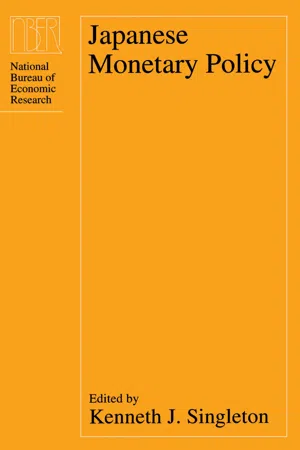Economics
Bank of Japan
The Bank of Japan is the central bank of Japan, responsible for issuing and controlling the country's currency, implementing monetary policy, and ensuring the stability of the financial system. It plays a crucial role in regulating the Japanese economy, managing inflation, and fostering economic growth through its monetary policy decisions and interventions in the financial markets.
Written by Perlego with AI-assistance
Related key terms
1 of 5
9 Key excerpts on "Bank of Japan"
- Michael Brandl(Author)
- 2020(Publication Date)
- Cengage Learning EMEA(Publisher)
The act also states the bank shall “always maintain close contact with the government and exchange views sufficiently.” We examine the issue of central bank independence in more detail in Chapter 11. Responsibilities of the Bank of Japan Issuing Bank Notes As with all central banks, the Bank of Japan is responsible for dissemi-nating the country’s currency and coins. In doing so, the Bank of Japan also guards against the counterfeiting of its currency. If you have ever seen a Bank of Japan bank note, you may notice the great lengths the Bank of Japan has gone to in order to frustrate counterfeiters: Yen notes are multicolored miniature pieces of art, complete with holograms and hidden text. To help disseminate these bank notes, the Bank of Japan has thirty-two branches across Japan and seven representative offices overseas. Financial Market Stability The Bank of Japan uses both off-site monitoring of commercial banks, in which Bank of Japan staff conduct research through interviews with financial institu-tion officials and gather financial market data, and on-site examinations, in which Bank of Japan staff visit depository institutions and investigate their safety and soundness. In its off-site moni-toring, the Bank of Japan staff watches the funding and investment policies, liquidity position, and profitability of depository institutions. During its on-site audits, Bank of Japan staff evaluate depository institutions’ internal control mechanisms and contingency plans: what the bank will do if something unexpected occurs, such as a natural disaster like an earthquake or typhoon or a financial disaster like a bank run and or stock market crash. If unexpected events, such as a global financial crisis, do occur, the Bank of Japan is ready to step in as a “lender of last resort” to the Japanese banking system.- Michael Brandl(Author)
- 2016(Publication Date)
- Cengage Learning EMEA(Publisher)
Due to electronic rights, some third party content may be suppressed from the eBook and/or eChapter(s). Editorial review has deemed that any suppressed content does not materially affect the overall learning experience. Cengage Learning reserves the right to remove additional content at any time if subsequent rights restrictions require it. 174 CHAPTER 2 Sample Design About Money Other Central Banks: Bank of Japan and Bank of England 8-4a Bank of Japan The central Bank of Japan, called the Bank of Japan, was founded in 1882 and has been in the same building in Tokyo since 1896. In 1998, with the passage of the Bank of Japan Act, the bank became an independent central bank. The act states “the Bank of Japan’s auton-omy regarding currency and monetary control shall be respected.” While this may sound like the act created a fully independent central bank, that’s not quite the complete story. The act also states the bank shall “always maintain close contact with the government and exchange views sufficiently.” We examine the issue of central bank independence in more detail in Chapter 11. Responsibilities of the Bank of Japan Issuing Bank Notes As with all central banks, the Bank of Japan is responsible for dissemi-nating the country’s currency and coins. In doing so, the Bank of Japan also guards against the counterfeiting of its currency. If you have ever seen a Bank of Japan bank note, you may notice the great lengths the Bank of Japan has gone to in order to frustrate counterfeiters: yen notes are multicolored miniature pieces of art, complete with holograms and hidden text. To help disseminate these bank notes, the Bank of Japan has 32 branches across Japan and 7 representative offices overseas.- Rodney Edvinsson, Tor Jacobson, Daniel Waldenström(Authors)
- 2018(Publication Date)
- Cambridge University Press(Publisher)
10 A History of the Bank of Japan, 1882–2016 Masato Shizume* 10.1 Introduction In this chapter, we review the history of the Bank of Japan (BOJ) with a focus on the changing role of the central bank and the transformation of the national economy (Table 10.1). When Japan joined the modern world in the late 19th century as a country with a small and open economy, the Bank was created as an entity to integrate the national financial market and provide liquidity for economic growth. By the early 20th century, Japan had succeeded in joining the modern world and began pursuing its goal as an empire. Under this condition, the Bank played a pivotal role in financing wars and in stabilizing the less-disciplined national financial market. Yet during and after Japan’s losing war with its main trading partners in the 1930s and 1940s, the Bank was overwhelmed by balloon- ing government debt and rampant inflation. When Japan re-focused its national goal on high economic growth during the 1960s and early 1970s, the Bank was revived as an engine to fuel liquidity into the national economy even without legal independence. Once the Japanese economy reached an advanced stage of development from the 1970s onward, the Bank’s main task changed from providing liquidity for economic growth to stabilizing the domestic economy. In pursuing its task, the Bank has often faced trade-offs between guns and butter, stability and growth, the threat of economic backlash and the moral hazard problem. The Bank has been and still is learning from new challenges. * The author thanks Ryoji Koike, Toshiki Jinushi, Kris James Mitchener, and Shigenori Shiratsuka for helpful comments. Earlier versions of this chapter were presented at the workshop, “Sveriges Riksbank 350 years: a central bank in a world of central banks,” and a seminar at the Bank of Japan. 328- eBook - ePub
Elements of the Euro Area
Integrating Financial Markets
- Mauro Grande(Author)
- 2018(Publication Date)
- Routledge(Publisher)
5 It is worth mentioning that in the case of the US, foreign exchange policy is fully in the hands of the Treasury Department. In Japan, foreign exchange interventions are decided by the finance ministry. The Bank of Japan undertakes these interventions as an agent of the government using government funds. As far as the euro area is concerned, Article 111 of the Treaty gives the Council (acting either on a recommendation from the Commission and after consulting the ECB or on a recommendation from the ECB) the right to formulate ‘general orientations for exchange rate policy’. At the same time, the Treaty also contains provisions ensuring that the pursuit of the objective of price stability is fully respected by the single exchange rate policy (ECB 2004).6 Both the ECB and the Fed are clear on being as comprehensive as possible in their analysis. They both incorporate in their analysis all possible pertinent information, all relevant forecasts and modelling exercises, including private sector views, whether economic or monetary.7 Some observers have made use of the wording ‘liquidity trap’ for this situation. We are not aware whether the BoJ itself agrees to this description.8 There are, of course, a number of remedies for the situation in Japan suggested in the literature. It would, however, lead us too far astray to touch upon this point. See, for instance, Bernanke (2003) for a recent assessment of the situation in Japan from the viewpoint of a Fed official.9 The interested reader can also refer to, for example, ECB (2004a), Bank of Japan (2004), Bank for International Settlements (2001).10 Although fiscal policies are subject to the provisions of the Stability and Growth Pact.References
Bank for International Settlements (2004),Bank of Japan (2000), ‘Functions and Business Operations of the Bank of Japan’, http//boj.or.jp.74th Annual Report, p. 22.Bank of Japan (2003), ‘About the Bank of Japan’, Annual Review - eBook - ePub
Role Of Central Banks In Financial Stability, The: How Has It Changed?
How Has It Changed?
- Douglas D Evanoff, Cornelia Holthausen, George G Kaufman, Manfred Kremer(Authors)
- 2013(Publication Date)
- WSPC(Publisher)
Section 6 , the paper concludes by deriving general lessons from the experience in Japan on the role of central banks in maintaining financial stability.2. Financial Instability in the 1920sThe Bank of Japan (BOJ) was established as the central bank in 1882. The bank was organized as a joint stock company, but it was tightly controlled by the government. The shareholders were limited to Japanese citizens, and they had to be approved by the Ministry of Finance before they could buy shares of the BOJ. The government was to monitor the business of the BOJ and had the power to prohibit not only the actions that violated the Bank of Japan Act or the charter, but also anything that was considered to be detrimental to the government’s interest. Under this heavy influence of the government, the BOJ often provided funds to private sector banks and industrial firms directly in the name of maintaining financial stability.The first systematic rescue loans by the BOJ happened in the post-war recession of 1920. Japanese industries expanded very rapidly during World War I, and suffered from over-extension when the war ended. In the spring of 1920, crashes in stock and commodity markets led to a financial crisis. Many banks were rumored to be in trouble and the depositors ran to their branches. From April to July 1920, there were 169 bank runs in total (BOJ, 1958, pp. 547–548). To respond to the crisis, the BOJ took several measures. First, the BOJ provided liquidity to the banking sector. For those banks that already had accounts at the BOJ, the BOJ increased the lending by relaxing the collateral requirements. In some cases, the BOJ extended loans without any collateral. The BOJ also extended credits to those banks that did not have prior transactions with the BOJ through purchase of government bonds that the banks held with repurchase agreements. - eBook - PDF
- John E. Marthinsen(Author)
- 2020(Publication Date)
- De Gruyter(Publisher)
As a result, Japanese banks ’ re-serves and Japan ’ s monetary base fall by ¥100 billion. These transactions are labeled #3 in Figure 9.21. Monetary Effects of Central Bank Foreign Exchange Market Intervention 233 – BOJ : Finally, the BOJ merely exchanges liabilities. It now owes ¥100 billion more to the ECB and ¥100 billion less to Japanese banks. As a result, Japan ’ s monetary base falls as domestic banks ’ deposits at the BOJ fall. These transactions are labeled #4 in Figure 9.21. Central Banks Around the World It is a fair generalization to say that all cases of hyperinflation experienced over the past 2,000 years have been caused by excessive money growth. For this rea-son, most nations (including the United States) have had strong interests in protecting their central banks from external pressures (e.g., political, media, and vested interests), while at the same time ensuring that there are checks and balances on their central banks ’ powers. Academic research has provided European Central Bank ( Figures in billions ) Euro-Area Banking Bank Japanese Banking Bank Bank of Japan Euros Yen BOJ ECB + €1 + €1 – ¥100 + ¥100 + ¥100 –¥100 4. Deposits (of ECB) 1. Deposits (of BoJ) 1. Deposits (of euro-area banks) Above the Line Below the Line 3. Deposits (of customers) 2. Reserves (Deposits at ECB) 4. Deposits (of Japanese banks) + €1 –¥100 3. Reserves (Deposits at BoJ) 2. Deposits (of customers) Foreign Exchange Market Figure 9.21: Effects When the ECB Buys Yen from the Nonbank Public or Governments. (Imagery used: © MicroOne/Shutterstock; © Sompop U-kong, liravega258/123rf) 234 Chapter 9 Central Banks strong evidence that independent central banks are best able to control their nations ’ inflation rates. 29 With some exceptions, there has been a clear global trend toward increasing central banks ’ independence from governments and ensuring that their operations and decisions are as transparent as possible. - Available until 4 Dec |Learn more
Elements of the Euro Area
Integrating Financial Markets
- Mauro Grande, Jesper Berg, Francesco Paolo Mongelli(Authors)
- 2018(Publication Date)
- Routledge(Publisher)
As regards the implementation stage, the Bank of Japan carries out its business operations through its head office in Tokyo, 33 branches (B), 13 local offices (LOs) and several overseas representative offices. The Financial Markets Department at the head office conducts daily market operations and intervenes in the foreign exchange markets. The tasks of the domestic branches include the conduct of (1) business operations relating to currency issue and (2) banking operations such as discounting of bills, extension of loans, purchases and sales of bills and services related to deposit accounts, treasury funds and Japanese government bonds. The local offices handle some of the business operations of the head office or branches.In addition to the monetary policy function, all three central banks perform other functions and tasks (see Table 2.1 for details). Several are common to all three central banks, including the issuance of banknotes, the operation of the payment system, the collection of statistical information and the holding of foreign exchange reserves. These functions are clearly of crucial importance for monetary policy and thus are, in practice, often assigned to the monetary authorities.Figure 2.5 The Bank of JapanSource: Bank of Japan (www.boj.or.jp ).The assignment of some other functions and tasks varies considerably across the three central banks. This is due, amongst others, to diverse factors that are not addressed here. One of these tasks worth mentioning is the responsibility for banking supervision and financial stability. Although the tasks of examination of depository institutions are delegated to the twelve Federal Reserve Banks, the determination of the general bank supervision policy is performed by the Federal Reserve Board in a centralized manner. In the euro area, instead, only some national central banks are involved in national supervision policies. The Bank of Japan supervises banks on a contractual basis. In order to receive emergency liquidity assistance, banks must provide the BoJ with regular information about their balance sheet and the BoJ can inspect them. The formal supervision of banks for financial stability purposes is carried out by the supervisory agency. - eBook - PDF
- Kenneth J. Singleton(Author)
- 2007(Publication Date)
- University of Chicago Press(Publisher)
The latter problem is also im- portant from the viewpoint of monitoring by the monetary authorities and financial system stability. References Bank of Japan. 1985. Nihon Ginko Hyakunenshi (Centennial history of the Bank of Japan). Vol. 5. Tokyo: Bank of Japan. . 1990. Financial Markets September 1990. Tokyo: Bank of Japan, October. Bryant, R. C. 1991. Model Representations of Japanese Monetary Policy. Bank of Dornbusch, R. 1986. Dollars, Debt, and Deficit. Cambridge, MA: MIT Press. Dotsey, M. 1986. Japanese Monetary Policy: A Comparative Analysis. Bank of Japan Monetary and Economic Studies 4, no. 2. Ito, T. 1991. Monetary Policy in the Age of Financial Innovations: The Case of Japan 1985-1990. Paper presented at the NBER conference on Japanese Monetary Policy, April. Iwamura, M. 1992. The Determination of Monetary Aggregates and Interest Rates. Bank of Japan Monetary and Economic Studies 10, no. 1:65-93. Kato, K. 1991. The Information Content of Financial and Economic Variables: Empir- ical Tests of Information Variables in Japan. Bank of Japan Monetaty and Economic Studies 9, no. 1:61-86. Mishkin, F. 1989. A Multi-country Study of the Information in the Term Structure about Future Inflation. NBER Working Paper No. 3125. Cambridge, MA: National Bureau of Economic Research, September. Nakao, M., and A. Horii. 1991. The Process of Decision-making and Implementation of Monetary Policy in Japan. Special Paper No. 198. Bank of Japan, March. Okina, K. 1987. Tankikinyushizyo Kinri to Kinyu Chosetsu (Short-term interest rates and monetary control in Japan). Discussion Paper No. 157. Institute of Economic Research, Hitotsubashi University, March. Short-Term Money Market Study Group. 1990. Wagakuni Tanki Kinyu Shijono Genjo to Kadai (Japan’s short-term money market and its issues). Tokyo: Kinyu Zaisei Jijo Kenkyukai. Japan Monetary and Economic Studies 9, no. 2: 1 1-61. - Takatoshi Ito, Andrew K. Rose, Takatoshi Ito, Andrew K. Rose(Authors)
- 2007(Publication Date)
- University of Chicago Press(Publisher)
A central bank may have to wait a desperately long time before such im-provements take place. Improvements in the economy may not materialize under the policy board that made the decision. As King (2004) points out, the di ffi culty here is one of “collective decisions today may fail to bind fu-ture collective decisions.” In any case, these points have to be at the center of discussion in any evaluation of the BOJ’s recent monetary policy. Finally, Ito and Mishkin’s discussion of the pros and cons of other non-conventional monetary-policy measures in the neighborhood of the ZLB is very reasonable. If I might add some obvious points, foreign exchange in-tervention may help in raising the price level. In the Japanese context, how-ever, the BOJ is not allowed to carry out exchange rate policy, which is in the hands of the MOF. The MOF, who has the power to carry out large in-terventions, ironically does not have the mandate to maintain price stabil-ity. Ito and Mishkin note various problems with operations in private real assets. I agree with most of what they say here. I would have then thought that the decision on whether or not to use such operations would be a func-tion of how desperate the situation of the economy was. In fact, the BOJ has been buying asset-backed securities since 2003 as a monetary-policy action, and equities from private banks since 2002 as a prudential policy measure. These reflected the BOJ’s judgment that the economy was in a se-rious situation, hence the use of some risky operations were justified, but that the situation was not desperate, therefore, they should be carried out with an eye to minimizing the negative e ff ects of such operations on private resource allocation. References Baba, N., N. Oda, S. Nishioka, M. Shirakawa, K. Ueda, and H. Ugai. 2004. Japan’s deflation, problems in the financial system and monetary policy. Paper presented at the 3rd Bank for International Settlements (BIS) annual conference, Brunnen, Switzerland.
Index pages curate the most relevant extracts from our library of academic textbooks. They’ve been created using an in-house natural language model (NLM), each adding context and meaning to key research topics.








